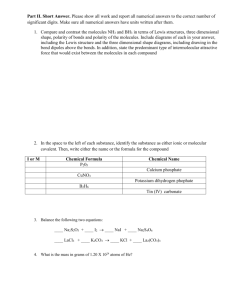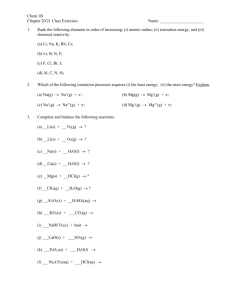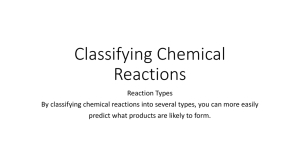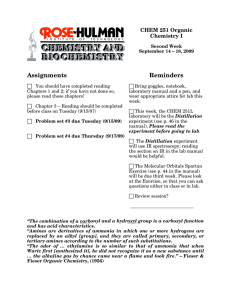THE PREFERENTIAL STRUCTURE OF Co SOLVATION
advertisement
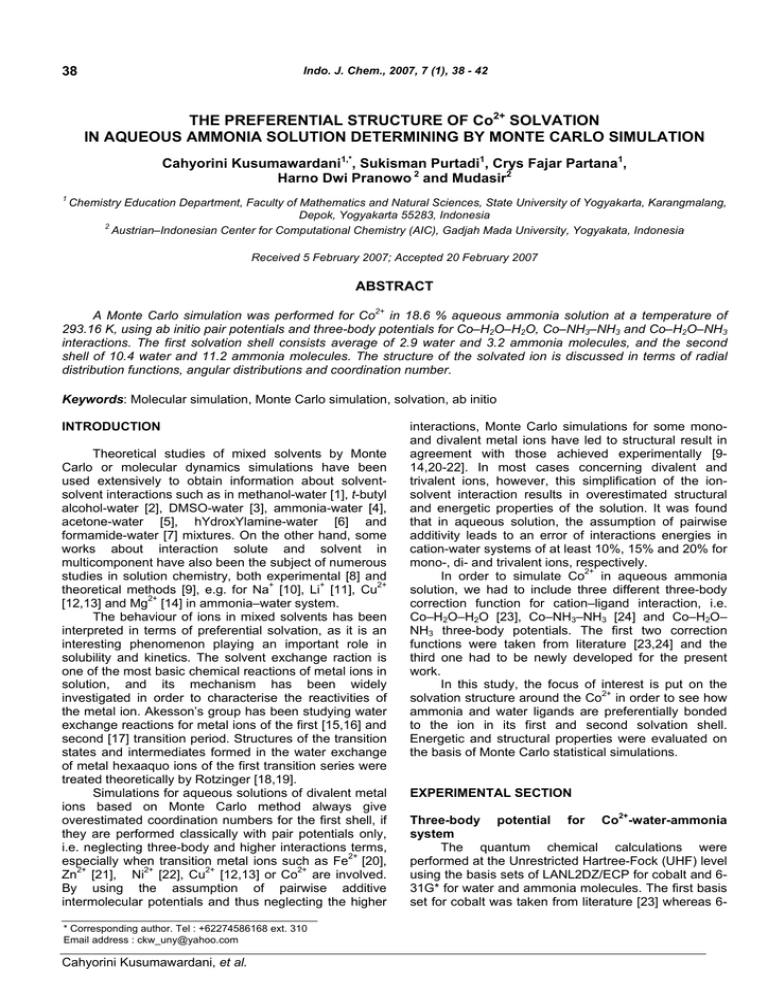
38
Indo. J. Chem., 2007, 7 (1), 38 - 42
THE PREFERENTIAL STRUCTURE OF Co2+ SOLVATION
IN AQUEOUS AMMONIA SOLUTION DETERMINING BY MONTE CARLO SIMULATION
Cahyorini Kusumawardani1,*, Sukisman Purtadi1, Crys Fajar Partana1,
Harno Dwi Pranowo 2 and Mudasir2
1
Chemistry Education Department, Faculty of Mathematics and Natural Sciences, State University of Yogyakarta, Karangmalang,
Depok, Yogyakarta 55283, Indonesia
2
Austrian–Indonesian Center for Computational Chemistry (AIC), Gadjah Mada University, Yogyakata, Indonesia
Received 5 February 2007; Accepted 20 February 2007
ABSTRACT
A Monte Carlo simulation was performed for Co2+ in 18.6 % aqueous ammonia solution at a temperature of
293.16 K, using ab initio pair potentials and three-body potentials for Co–H2O–H2O, Co–NH3–NH3 and Co–H2O–NH3
interactions. The first solvation shell consists average of 2.9 water and 3.2 ammonia molecules, and the second
shell of 10.4 water and 11.2 ammonia molecules. The structure of the solvated ion is discussed in terms of radial
distribution functions, angular distributions and coordination number.
Keywords: Molecular simulation, Monte Carlo simulation, solvation, ab initio
INTRODUCTION
Theoretical studies of mixed solvents by Monte
Carlo or molecular dynamics simulations have been
used extensively to obtain information about solventsolvent interactions such as in methanol-water [1], t-butyl
alcohol-water [2], DMSO-water [3], ammonia-water [4],
acetone-water [5], hYdroxYlamine-water [6] and
formamide-water [7] mixtures. On the other hand, some
works about interaction solute and solvent in
multicomponent have also been the subject of numerous
studies in solution chemistry, both experimental [8] and
theoretical methods [9], e.g. for Na+ [10], Li+ [11], Cu2+
[12,13] and Mg2+ [14] in ammonia–water system.
The behaviour of ions in mixed solvents has been
interpreted in terms of preferential solvation, as it is an
interesting phenomenon playing an important role in
solubility and kinetics. The solvent exchange raction is
one of the most basic chemical reactions of metal ions in
solution, and its mechanism has been widely
investigated in order to characterise the reactivities of
the metal ion. Akesson’s group has been studying water
exchange reactions for metal ions of the first [15,16] and
second [17] transition period. Structures of the transition
states and intermediates formed in the water exchange
of metal hexaaquo ions of the first transition series were
treated theoretically by Rotzinger [18,19].
Simulations for aqueous solutions of divalent metal
ions based on Monte Carlo method always give
overestimated coordination numbers for the first shell, if
they are performed classically with pair potentials only,
i.e. neglecting three-body and higher interactions terms,
especially when transition metal ions such as Fe2+ [20],
Zn2+ [21], Ni2+ [22], Cu2+ [12,13] or Co2+ are involved.
By using the assumption of pairwise additive
intermolecular potentials and thus neglecting the higher
* Corresponding author. Tel : +62274586168 ext. 310
Email address : ckw_uny@yahoo.com
Cahyorini Kusumawardani, et al.
interactions, Monte Carlo simulations for some monoand divalent metal ions have led to structural result in
agreement with those achieved experimentally [914,20-22]. In most cases concerning divalent and
trivalent ions, however, this simplification of the ionsolvent interaction results in overestimated structural
and energetic properties of the solution. It was found
that in aqueous solution, the assumption of pairwise
additivity leads to an error of interactions energies in
cation-water systems of at least 10%, 15% and 20% for
mono-, di- and trivalent ions, respectively.
In order to simulate Co2+ in aqueous ammonia
solution, we had to include three different three-body
correction function for cation–ligand interaction, i.e.
Co–H2O–H2O [23], Co–NH3–NH3 [24] and Co–H2O–
NH3 three-body potentials. The first two correction
functions were taken from literature [23,24] and the
third one had to be newly developed for the present
work.
In this study, the focus of interest is put on the
solvation structure around the Co2+ in order to see how
ammonia and water ligands are preferentially bonded
to the ion in its first and second solvation shell.
Energetic and structural properties were evaluated on
the basis of Monte Carlo statistical simulations.
EXPERIMENTAL SECTION
Three-body potential for Co2+-water-ammonia
system
The quantum chemical calculations were
performed at the Unrestricted Hartree-Fock (UHF) level
using the basis sets of LANL2DZ/ECP for cobalt and 631G* for water and ammonia molecules. The first basis
set for cobalt was taken from literature [23] whereas 6-
39
Indo. J. Chem., 2007, 7 (1), 38 - 42
31G* basis set was provided by Gaussian98 program.
The experimental gas-phase geometry of the ammonia
[25] (N–H distance at 1.0124 Å and H–N–H angle of
106.67) and water [26] (O–H distance of 0.9601 Å and
H–O–H angle of 104.47o) were kept rigid throughout the
calculations. All ab initio calculations were carried out
using Gaussian98 program [27].
The three body potential Co2+-H2O-NH3 was
constructed from 2430 configurations that generated by
varying the distance and orientation of the ligands in the
configuration space around the cobalt ion. Orientation
where one of the hydrogen atoms is closer to the ion
than the corresponding nitrogen or oxygen, respectively,
need not be considered as their highly repulsive twobody interaction energy values prevent the occurrence of
such orientation during the simulation process. The
three-body interaction energy, ΔE3b , for each
where L1 and L2 denote the center of mass of water and
ammonia molecule, respectively, θ L ML is the H2O–Co–
Monte Carlo simulation
In order to perform the simulation for the system
consisting of one Co2+ surrounded by ammonia and
water molecules, five-pair potentials and three-body
potentials were required. For water-water interactions,
the CF2 potential of Jansco and Heinzinger [28] was
used, and the pair potential of Hannongbua et al. [29]
for ammonia-ammonia interactions. Ammonia-water
interaction energies were evaluated using the potential
function developed by Tanabe and Rode [4] adopting
the same scaling factor to obtain better energetic data.
The pair and the three-body potentials for
describing Co2+–water and Co2+–ammonia interactions
were taken from our previous work [23,24]. The new
three-body potential for Co2+–water–ammonia of this
work was used in addition.
The simulation box contained one cobalt, 171
water and 39 ammonia molecules corresponding to
18.6% aqueous ammonia solution at the temperature
of 6 K. The density of 0.9291 g cm-3 for this solution at
the specified temperature gives an edge length of
18.951 Å for the elementary box. Periodic boundary
conditions and a cutoff at half of this length [30] for
exponential terms were employed, and the starting
configuration was randomly generated. The Metropolis
sampling algorithm [31] was used and structural data
were evaluated for 3 million configurations after the
system had reached energetic equilibrium after 4
million configurations.
Beside radial distribution functions and their
integrations for various pairs of species, the first
solvation shell has been the subject of detailed analysis
regarding coordination number and angular ligand
molecule distributions.
NH3 angle and rML1 and rML2 are the distance between
RESULT AND DISCUSSION
configuration was computed by subtracting the two-body
interactions, ΔE 2 b , calculated with the help of the pair
potential functions for cobalt-ammonia, cobalt-water and
ammonia-water, from the ab initio energies in the
following way :
ΔE 3bd = {E ML1L 2 − E M − E L1 − E L2 }− {E 2bML1 }− {E 2bML2 }− {E 2bL1L2 }
(1)
where M, L1 and L2 denote cobalt, water and ammonia,
respectively. All three-body data points were fitted to an
analytical function to be used as correction for the pair
potentials. The form of this correction function is
2
ΔE3bd = 0.05721[1.00682 + ( π − θL1ML2 )2 ]2 x exp (0.963 x rML
)
1
2
2
2
x exp (0.8144 x rML
) x [(CL2 − rML
)(CL2 -rML
)]
2
1
2
1
(2)
2
the center mass of water and ammonia and Co2+
respectively. CL represents a cutoff limit to be used in
the simulation, beyond which three-body effects can be
neglected. In our case CL was set to 6.0 Å.
Tabel 1. Characteristic values
aqueous ammonia solution;
rM1
α
β
Co2+-H2O
Co
O
2.08
H
2.78
Co
Co2+-NH3
Co
N
2.26
Co
H
2.72
Radial distribution functions
Characteristic values of radial distribution
functions for Co2+ in 18.6% aqueous ammonia solution
are shown in Table 1.
of the radial distributions functions for the Co(II) in 18.6%
rm1
nαβ(m1)
rM2
rm2
nαβ(m2)
2.54
3.16
2.9
5.9
4.32
4.9
4.90
5.92
10.4
31.2
2.70
3.35
3.2
9.4
4.57
4.62
5.27
5.86
11.21
44.33
Note : rM1 and rM2 are first and second maximum in Å; rm1 and rm2 are the first and second minimum in Å, where nαβ(r)
are the first and second coordination number from the running integration numbers integrated up to rm1 and rm2,
2+
respectively. α is Co and β is the atom of ligand.
Cahyorini Kusumawardani, et al.
40
Indo. J. Chem., 2007, 7 (1), 38 - 42
10
40
RDF Co-O
RDF Co-N
n Co-N
n Co-O
RDF Co-Ha
RDF Co-Hw
8
30
nCo-Hw
n Co-Ha
RDF
RDF
6
20
4
10
2
0
0
0
2
4
D ist ance ( A )
6
8
10
0
2
4 Distance (A) 6
8
10
(a)
(b)
Fig 1. (a) Co-O and Co-Hw radial distribution functions and their running integration numbers obtained from the
simulation of Co2+ in 18,6 % aqueous ammonia solution; (b) Co-N and Co-Ha radial distribution functions and their
running integration numbers obtained from the simulation of Co2+ in 18,6 % aqueous ammonia solution
Cahyorini Kusumawardani, et al.
O-Co-O
7
N-Co-N
6
occurence (%)
Co2+–O and Co2+–Hw radial distribution functions
(RDFs) and their corresponding integration are shown in
Fig 1(a). From the graphic in Fig 1a and Table 1, the first
maximum (rM1) for the Co2+–O (2.08 Å) is 0.05 Å closer
than observed for Co2+ in pure water [23]. The average
2.9 water molecules contained in the first shell, nCo–
O(m1), are well separated from the second shell as can
be seen from the Co2+–O RDF values of zero over quite
some distance (2.4–3.3 Å), and little exchange of water
molecules between the first and second solvation shell
was observed throughout the simulation, as expected for
such strong ion–solvent interactions. The Co2+–Hw RDFs
shows a sharp peak (rM1) centered at 2.78 Å
representing the water hydrogen of the first solvation
sphere of Co2+. This peak does not overlap with the
Co2+–O RDF, indicating that the first solvation shell
structure is rather rigid with the oxygen oriented toward
the central ion in dipole moment direction. The average
coordination number nCo–H(m1) for hydrogen atom is 5.9
corresponding to the 2.9 water molecules in the first
shell within 2.7 Å. The region from ~3.2 Å up to ~4.8 Å
corresponds to the second hydration shell with the
maximum of the Co–O RDF at 4.6 Å, containing an
average number of 10.4 water molecules.
The Co2+–N and Co2+–HA RDFs and their
corresponding integration are shown in Fig 1(b). The
functions are characterised by well-pronounced first
solvation shell peak at 2.26 Å, only 0.02 Å further away
than for Co2+ in pure liquid ammonia [24]. The average
coordination number for this first shell is 3.2. Exchange
of ammonia molecules between the first and second
shells should be slow, since the Co2+–N RDF becomes
almost zero over a considerable distance (2.5–3.2 Å). All
hydrogen atoms corresponding to the 3.2 NH3 ligands
are placed beyond the Co2+–N RDF and the first Co2+–
HA RDF peak is centered at 2.72 Å, containing 9.4
hydrogen atoms as expected. The second solvation shell
of Co2+ is represented by a broad peak between 3.3 and
6.3 Å with the maximum of the Co2+–N RDF at 4.6 Å,
O-Co-N
5
4
3
2
1
0
60
80
100
120
L1-Co-L2 angle (deg)
140
160
180
Fig 2. Angular distribution functions for NH3-Co-NH3,
H2O-Co-H2O and H2O-Co-NH3 in the first salvation
18,6 %
shell obtained from the simulation of Co2+ in
aqueous ammonia solution
containing an average number of 11.2 ammonia
molecules.
Angular distributions
The structure of ligand around Co2+ in the first
solvation shell was further analysed with respect to the
ligand-ion-ligand angle distribution (Fig. 2). The
distribution plots for H2O–Co–H2O and NH3–Co–NH3
angles show one peak each, centered at 87o and 81o,
respectively, meaning that in this complex two water or
two ammonia molecules are never located in trans
position in each other. This actually means that Co2+ is
embedded into two hemispheres, one consisting
approximately of three water and one approximately of
three ammonia molecules. The NH3–Co–H2O angle
distribution shows two peaks centered at 93o and 173o.
The structure of the 6 ligands in the first solvation shell
is a distorted octahedron, the 3 water ligands being
0.18 Å closer to Co2+ than the three ammonia ligands.
41
Indo. J. Chem., 2007, 7 (1), 38 - 42
Coordination number distributions
100
Co-w ater
Co-ammonia
Cahyorini Kusumawardani, et al.
80
occurence (%)
Fig 3 shows the coordination number distribution of
the first and second solvation shells of Co2+. The first
shell coordination number distribution of Co2+–H2O and
Co–NH3, shows that the first solvation shell consists
approximately of three ammonia and three water
molecules. This fact also indicates a slow exchange rate
for the first solvation shell ligands.
The second shell coordination number distribution
(Fig 3) shows that on average 10.4 water and 11.2
ammonia molecules interact with the molecules in the
first shell. Configurations with 10 (25%) water molecules
and 12 (44.3%) ammonia molecules dominate. One can
see from Fig. 3 that the coordination number for Co–H2O
(8–15) is considerably wider than for Co–NH3 (8–12).
This wider range coordination number reflects a less
rigid bonding and thus the majority of second shell ligand
exchange processes should involve water molecules.
The average solvation structure of Co2+ in 18.6%
aqueous ammonia solution can thus be characterized by
Co[(H2O)2.9(NH3)3.2] [(H2O)10.4(NH3)11.2]2+. This means
that in this solution, Co2+ is preferentially solvated by
ammonia ligands in the first solvation shell and even the
second solvation shell. This preferential solvation
denotes the over-representation of ammonia ligands in
the solvation shell compared to their presence in the
bulk.
The number of ligands in the first and second
solvation shells of Li+, Na+, Mg2+, and Cu2+ are compared
to those of Co2+. The fully solvated sodium ion in 18.45
% aqueous ammonia can be characterised by
Na[(H2O)2.4(NH3)4] [(H2O)7(NH3)2]+ [10], the first solvation
being dominated by ammonia and the second shell by
water. Li+ and Mg2+ are preferentially solvated by water
in both shells. The structure of solvated lithium and
magnesium ions can be characterised by Li[(H2O)4
(NH3)2][(H2O)8(NH3)4]+ [11] and Mg[(H2O)4(NH3)3][(H2O)9
(NH3)5]2+ [14], respectively. While, the solvated Cu2+
which can be characterised by Cu[(H2O)3(NH3)3]
[(H2O)11.6(NH3)10.2]2+ [12], shows that it was preferentially
solvated by ammonia ligands in both shells. The results
for ions with the same charge and similar radius (Mg2+,
Cu2+ and Co2+) are quite different. The origin of the
difference is to be seen in the relative hardness and
softness of acids (ions) and bases (ligands) and the
involvement of d functions of Cu2+ and Co2+ in ligand
binding. This data must be seen with some caution,
however, as n-body effects have recently been found to
be of considerable importance even for mono- and
divalent main group metal ions in solution: a molecular
dynamics simulation using a mixed quantum
mechanical/molecular mechanical (QM/MM) method,
gave a tetrahedral structure with 3 water and 1 ammonia
ligand for the first hydration shell of Li+, in contrast to the
structure predicted by classical pair potential simulations
[32]. In the QM/MM technique, the many-body contri-
60
40
20
0
0
2
3
4
5
6
7
8
9
10
11
12
13
14
15
coordination number
Fig 3. First- and second shell coordination number
distribution of Co2+-water and of Co2+-ammonia in 18,6
% aqueous ammonia solution
butions for the whole first solvation shell are included
and lead approximately to quite substantial
corrections–although qualitatively most probably
correct.
The result of Monte Carlo simulation would be
different if it is simulated in the different concentration,
which the higher ammonia concentration the more
ammonia ligand would be coordinated around the ion
exchanging water molecule. On the other hand, the
smaller concentration it would be less ammonia ligand
which replacing the water molecule.
CONCLUSION
Our Monte Carlo simulations of Co2+ in 18.6% of
aqueous ammonia solution using pair potential and
three-body correction functions characterise the
solvated
ion
as
Co[(H2O)2.9(NH3)3.2]
[(H2O)10.4(NH3)11.2]2+. Co2+ is preferentially solvated by
ammonia ligands in both solvation shells and the first
shell shows the expected distorted octahedral
structure. Preferential solvation phenomena are clearly
indicated, strong in favour of NH3 ligands.
ACKNOWLEDGEMENT
Financial support from Indonesian Government by
Directorate General of Higher Education through Hibah
PEKERTI project (contract no. 01/J.35/KTR.HP/2006)
is gratefully acknowledged.
REFFERENCES
1. Ohtaki, S; Touhara, H. and Nakanishi, K.; 1984, J.
Chem. Phys. 81, 890.
2. Tanaka, H.; Nakanishi, K. and Touhara, H.; 1984,
J. Chem Phys. 81, 4065.
3. Vaisman, I. I. and Berkowitz, M. L; 1992, J. Am.
Chem. Soc. 114, 7889.
42
Indo. J. Chem., 2007, 7 (1), 38 - 42
4. Tanabe, Y. and Rode, B. M.; 1988, J. Chem. Soc.,
Faraday Trans. 2, 84, 679.
5. Ferrario, M.; Haughney, M. H.; McDonald, I. R. and
Klein, M. L.; 1990,
J. Chem. Phys. 93,
5156.
6. Visozo, S.; Heinzle, M. G. and Rode, B. M.; 1994, J.
Chem. Soc., Faraday trans. 90, 2337.
7. Puhovski, Y. P. and Rode, B. M.; 1995, J. Phys.
Chem. 99, 1566.
8. Mafune, F.; Hashimoto, Y. and Kondow T., 1997,
Chem. Phys. Lett. 274, 127.
9. Narusawa, H. and Nakanishi, K., 1990, J. Chem.
Phys. 73, 4066.
10. Rode, B. M. and Tanabe, Y., 1988, J. Chem. Soc.,
Faraday Trans. 2, 84, 1779.
11. Tongraar, A. and Rode, B. M., 1999, J. Phys. Chem.
A 103, 8524.
12. Pranowo, H. D. and Rode, B. M., 2000, J. Chem.
Phys. 112, 4212.
13. Pranowo, H. D. and Rode B. M., 2001, Chem. Phys.
263, 1.
14. Kheawsrikul, S.; Hannongbua, S. V. and Rode, B.
M., 1990, Z. Naturforsch A 46, 111.
15. Akesson, R.; Pettersson, L. G. M.; Sandström, M.;
Siegbhan, P. E. M. and Wahlgren, U., 1993, J. Phys.
Chem. 97, 3765.
16. Akesson, R.; Pettersson, L. G. M.; Sandström, M.
and Wahlgren, U., 1994, J. Am. Chem. Soc. 116,
8691.
17. [17].
Akesson, R.; Pettersson, L. G. M.;
Sandström, M. and Wahlgren, U., 1994, J. Am.
Chem. Soc. 116, 8705.
18. Rotzinger, F. P., 1996, J. Am. Chem. Soc. 118,
6760.
19. Rotzinger, F. P., 1997, J. Am. Chem. Soc. 118,
5230.
20. Lafont, A. G.; Lluch, J. M.; Olivia, A. and Bertran, J.,
1987, Chem Phys. 111, 2319.
Cahyorini Kusumawardani, et al.
21. Marini, G. W.; Texler, N. R. and Rode, B. M., 1996,
J. Phys. Chem. 100, 6808.
22. Pranowo, H. D. and Rode, B. M., 1999, J. Phys.
Chem. A 103, 4298.
23. Kusumawardani, C.; Pranowo, H. D.; Mudasir and
Partana, C. F., 2006, Indo. J. Chem. Vol 6, 3, 280.
24. Pranowo, H. D.; Kusumawardani, C.; Mudasir and
Purtadi, S., 2006, Chem. Phys. 324, 573.
25. Benedict W. S. and Player, E. K., 1985, Can. J.
Phys. 35, 890.
26. Kuchitzu, K.and Morino, Y., 1965, Bull. Chem. Soc.
Jpn, 38, 814.
27. Frisch, M. J.; Trucks, G. W.; Sclegel, H. B.; Gill, P.
M. W.; Johnson, B. G.; Robb, M. A.; Cheeseman,
J. R.; Keith, T. A.; Petersson, G. A.; Montgomery,
J. A.; Raghavachari, K.; Al-Laham, M. A.;
Zakrzewski, V. G.; Ortiz, J.V.; Foresman, J. B.;
Cioslowski, J.; Stefanov, B. B.; Nanayakkara, A.;
Challacombe, M.; Peng, C. Y.; Ayala, P. Y.; Chen,
W.; Wong, M. W.; Andres, J. L.; Replogle, E. S.;
Gomperts, R.; Martin, R. L.; Fox, D. J.; Binkley, J.
S.; Defrees, D. J.; Baker, J.; Stewart, J. J. P.;
Head-Gordon, M.; Gonzales, C.; Pople, J. A., 1999,
GAUSSIAN 98, Gaussian, Inc., Pittsburgh, PA.
28. Jansco, G. and Heinzinger, K.Z., 1985,
Naturforsch, Part A 40, 1235.
29. Hannongbua, S,; Ishida, T.; Spohr, E. And
Heinzinger, K., 1988, Z. Naturforsch. 43a, 572.
30. Allen, M. P. and Tiedesley, D. J., 1987, Computer
Simulation of Liquids, Oxford University Press,
Oxford.
31. Metropolis, N.; Rosenbluth, A. W. and Teller, E.,
1953, J. Chem Phys. 21, 1087.
32. Marini, G. W.; Liedl, K.R. and Rode, B. M., 1996, J.
Phys. Chem. A 284, 6808.

